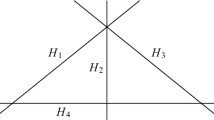Abstract
We show how the results of Dowling and Wilson on Whitney numbers in ‘The slimmest geometric lattices’ imply minimum values for the numbers of k-dimensional flats and d-dimensional cells of a projective d-arrangement of hyperplanes and for the number of d-cells missed by an extra hyperplane. Their theorems also characterize the extremal arrangements. We extend their lattice results to doubly indexed Whitney numbers; thence we obtain minima for the number of k-dimensional cells and the number of pairs of flats with x \(\subseteq\) y and dim x=k, dim y=l. The lower bounds are in terms of the rank and number of points of the geometric lattice, or the dimension d and the number of hyperplanes of the arrangement. The minima for k-cells were conjectured by Grünbaum; R. W. Shannon proved the minima for k-dimensional flats and cells and characterized attainment for the latter by a more strictly geometric, non-latticial technique.
Similar content being viewed by others
References
Basterfield, J. G. and Kelly, L. M.: ‘A Characterization of Sets of n Points which Determine n Hyperplanes’, Proc. Cambridge Philos. Soc. 64 (1968), 585–588. (MR 38, # 2040.)
Birkhoff, G.: Lattice Theory (3rd edn). Amer. Math. Soc. Colloq. Publ. Vol. 25, American Mathematical Society, Providence, R.I., 1967. (MR 37, # 2638.)
Bland, R. G. and Las Vergnas, M.: ‘Orientability of Matroids’, J. Comb. Theory Ser. B 24 (1978), 94–123. (MR 58, # 5294.)
Brylawski, T.: ‘A Combinatorial Perspective on the Radon Convexity Theorem’, Geom. Dedicata 5 (1976), 459–466. (MR 55, # 13340.)
Cordovil, R.: ‘Sur l'évaluation t(M;2,0) du polynôme de Tutte d'un matroïde et une conjecture de B. Grünbaum relative aux arrangements de droites du plan’, Europ. J. Comb. 1 (1980), 317–322. (MR 82j: 05046.)
Crapo, H. H. and Rota, G. C.: Combinatorial Geometries, Preliminary edn, MIT Press, Cambridge, Mass., 1970. (MR 45, # 74.)
Dowling, T. A. and Wilson, R. M.: ‘The Slimmest Geometric Lattices’, Trans. Amer. Math. Soc. 196 (1974), 203–215. (MR 49, # 10579.)
Eckhoff, J.: ‘Radon's Theorem Revisited’, Contributions to Geometry, Proc. Geometry Symp., Siegen, 1978, J. Tölke and J. M. Wills, eds, Birkhäuser, Basel, 1979, pp. 164–185. (MR 81f: 52016.)
Folkman, J. and Lawrence, J.: ‘Oriented Matroids’, J. Comb. Theory Ser. B 25 (1978), 199–236. (MR 81g: 05045.)
Greene, C.: ‘A Rank Inequality for Finite Geometric Lattices’, J. Comb. Theory 9 (1970), 357–364. (MR 42, # 1727.)
Greene, C. and Zaslavsky, T.: ‘On the Interpretation of Whitney Numbers through Arrangements of Hyperplanes, Zonotopes, Non-Radon Partitions, and Orientations of Graphs’, Trans. Amer. Math. Soc. (in press).
Grünbaum, B.: Convex Polytopes, Interscience, New York, 1967. (MR 37, # 2085.)
Grünbaum, B.: ‘Arrangements of Hyperplanes’, Proc. Second Louisiana Conf. on Combinatorics, Graph Theory and Computing (Baton Rouge, 1971), R. C. Mullin et al., eds, pp. 41–106. (MR 47, # 9428.)
Las Vergnas, M.: ‘Matroïdes orientables’, C.R. Acad. Sci. Paris Ser. A 280 (1975), A61-A64. (MR 51, # 7910.)
Las Vergnas, M.: ‘Convexity in Oriented Matroids’, J. Comb. Theory Ser. B 29 (1980), 231–243. (MR 82f: 05027.)
Rota, G.-C.: ‘On the Foundations of Combinatorial Theory. I: Theory of Möbius Functions’, Z. Wahrschein. 2 (1964), 340–368. (MR 30, # 4688.)
Shannon, R. W.: ‘A Lower Bound on the Number of Cells in Arrangements of Hyperplanes’, J. Comb. Theory Ser. A 20 (1976), 327–335. (MR 53, # 14321.)
Welsh, D. J. A.: Matroid Theory, Academic, London, 1976. (MR 55, # 148.)
Zaslavsky, T.: ‘Facing up to Arrangements: Face-Count Formulas for Partitions of Space by Hyperplanes’, Mem. Amer. Math. Soc. 1(1975), Issue 1, No. 154. (MR 50, # 9603.)
Zaslavsky, T.: ‘A Combinatorial Analysis of Topological Dissections’, Advances in Math. 25 (1977), 267–285. (MR 56, # 5310.)
Zaslavsky, T.: ‘Arrangements of Hyperplanes: Matroids and Graphs’, Proc. Tenth Southeastern Conf. on Combinatorics, Graph Theory and Computing (Boca Raton, 1979), F. Hoffman et al., eds, Utilitas Math. Publ. Inc., Winnipeg, Man., 1979, Vol. II, pp. 895–911. (MR 81h: 05043.)
Zaslavsky, T.: ‘The Slimmest Arrangements of Hyperplanes. II: Basepointed Geometric Lattices and Euclidean Arrangements’, Mathematika 28 (1981), 169–190.
Author information
Authors and Affiliations
Additional information
Research supported by SGPNR Grant No. 74ZZ*08 and NSF Grant No. MCS-8003109.
Rights and permissions
About this article
Cite this article
Zaslavsky, T. The slimmest arrangements of hyperplanes. Geom Dedicata 14, 243–259 (1983). https://doi.org/10.1007/BF00146905
Received:
Issue Date:
DOI: https://doi.org/10.1007/BF00146905




